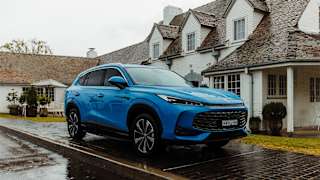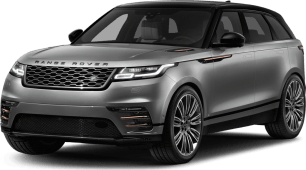All Velars have similar mechanical specs - they're AWD and come with an eight-speed automatic transmission. As with most of the rest of the shared Jaguar Land Rover stables, there are four trim levels in the range - the vanilla Velar, then S, SE with the range topped by the HSE (until the SVAutobiography arrives).
How much your Velar will cost is dependent on an unusually high set of variables - all eight (eight!) engine specifications are available with all four specs, so the price list stretches on forever.
For a detailed model comparison, check out our snapshots. All prices are quoted in RRP (or MSRP as the manufacturers suggest) and the drive-away price is subject to the usual taxes and charges.
The entry-point is the $71,033 Velar D180, but this standard features list applies to every available engine.
You get 18-inch alloy wheels, an eight-speaker stereo, dual-zone climate control, cruise control, reversing camera, keyless entry and start, front and rear parking sensors, remote app, auto LED headlights, auto wipers, leather and suede trim, power tailgate and a space-saver spare.
There's no sat nav (an almost $2000 option) on this car, which would be fine if it had Apple CarPlay and Android Auto. Which, for a solid $520 via the 'Smartphone Pack', you can have. Cheaper than sat nav, yes, but it would be nice if it were standard.
Each spec level is also available with the R-Dynamic package, which is essentially a styling pack for inside and out - different wheels, upgrades to seat leather, aluminium trim pieces and, on some models, an upgrade to the sound system. R-Dynamic adds around $6000 to the price of each trim level and inclusions are slightly different between the models.
The big price jump to the S adds 19-inch alloys, an 11-speaker stereo, ambient interior lighting, electric front seats, sat nav, auto high beam, LED headlights with signature DRLS, puddle lamps, Wi-Fi hotspot with on-board SIM card slot, powered and heated folding mirrors and road-sign recognition.
The SE builds again with about a $5000 price increase, with 20-inch alloys, a 17-speaker stereo, side parking sensors, digital dash, matrix LED headlights, self parking, scuff plates and reverse cross traffic alert.
The top-end HSE nabs you 21-inch alloys, massaging front seats with heating and ventilation and metallic interior finishes.
At the end of 2019 (fingers crossed) the Velar SVAutobiography Dynamic Edition will arrive. Priced at $175,322, it comes with a fair chunk of the HSE's equipment list, quilted perforated leather trim, knurled aluminium switchgear, 21-inch alloys, electronic active differential, sports adaptive dampers and various styling features.
And a bellowing 405kW 5.0-litre supercharged V8, which, in other JLR cars, can wake the dead, so with the variable active exhaust, prepare for neighbours complaining.
Each Velar comes with JLR's new stacked touchscreen technology, 'Touch Pro Duo'. With two big touchscreens, one high in the dash as before and one where the dash meets the console, it allows you to spread the different functions across the two screens.
As has been the case over the last few years, it's better than before, with much faster hardware. It also includes Apple CarPlay and Android Auto (finally) but you have to pay $590 for the privilege. You've also got USB and Bluetooth connectivity. Physical media fans will be disappointed by the lack of a CD player.
The colour range is suspiciously short - 'Narvik Black' and 'Fuji White' are freebies. 'Byron Blue', 'Kaikoura Stone' (bronze? brown?), 'Corris Grey', 'Firenze Red', 'Yulong White' and 'Indus Silver' are all $1780 while 'Aruba' and 'Silicon Silver' weigh in at $3550.
Gold and orange fans will be disappointed.
The lengthy optional features list includes the nifty activity key, sunroof (if not already standard), upgraded multimedia and sound system, upgraded navigation system, black pack or individual black bits, self parking/park assist, various accessories, floor mats (ahem), different size wheel rims and designs, air suspension, matrix LED lights... the list goes on. And on.





